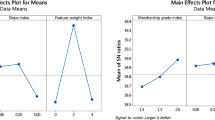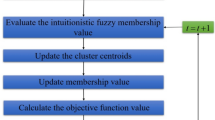Abstract
In the era of big data, the research on clustering technologies is a popular topic because they can discover the structure of complex data sets with minimal prior knowledge. Among the existing soft clustering technologies, as an extension of fuzzy c-means (FCM) algorithm, the intuitionistic FCM (IFCM) algorithm has been widely used due to its superiority in reducing the effects of outliers/noise and improving the clustering accuracy. In the existing IFCM algorithm, the measurement of proximity degree between a pair of objects and the determination of parameters are two critical problems, which have considerable effects on the clustering results. Therefore, we propose an improved IFCM clustering technique in this paper. Firstly, a novel weighted proximity measure, which aggregates weighted similarity and correlation measures, is proposed to evaluate not only the closeness degree but also the linear relationship between two objects. Subsequently, genetic algorithms are utilized for identifying the optimal parameters. Lastly, experiments on the proposed IFCM technique are conducted on synthetic and UCI data sets. Comparisons with other approaches in cluster evaluation indexes indicate the effectiveness and superiority of our method.













Similar content being viewed by others
Explore related subjects
Discover the latest articles and news from researchers in related subjects, suggested using machine learning.References
Zadeh LA (1965) Fuzzy sets. Inf Comput 8:338–353
Atanassov KT (1986) Intuitionistic fuzzy sets. Fuzzy Sets Syst 20(1):87–96
Aruna Kumar SV, Harish BS (2018) A modified intuitionistic fuzzy clustering algorithm for medical image segmentation. J Intell Syst 27(4):593–607
Lingras P, West C (2004) Interval set clustering of web users with rough k-means. J Intell Inf Syst Integr Artif Intell Database Technol 23(1):5–16
Bai C, Zhang R, Qian L, Liu L, Wu Y (2018) An ordered clustering algorithm based on fuzzy c-means and PROMETHEE. Int J Mach Learn Cybern 10(6):1423–1436
Mitra S, Pedrycz W, Barman B (2010) Shadowed c-means: Integrating fuzzy and rough clustering. Pattern Recogn 43(4):1282–1291
Zhou J, Lai Z, Miao D, Gao C, Yue X (2020) Multigranulation rough-fuzzy clustering based on shadowed sets. Inf Sci 507:553–573
Yu H (2017) A framework of three-way cluster analysis. In: International joint conference on rough sets (IJCRS 2017). Springer, pp 300–312
Yu H, Zhang C, Wang G (2016) A tree-based incremental overlapping clustering method using the three-way decision theory. Knowl Based Syst 91:189–203
Ludwig SA (2015) MapReduce-based fuzzy c-means clustering algorithm: implementation and scalability. Int J Mach Learn Cybern 6(6):923–934
Xu Z, Wu J (2010) Intuitionistic fuzzy C-means clustering algorithms. J Syst Eng Electron 21(4):580–590
Jain N, Kumar V (2016) IFCM based segmentation method for liver ultrasound images. J Med Syst 40(11):1–12
Son LH, Cuong BC, Lanzi PL, Thong NT (2012) A novel intuitionistic fuzzy clustering method for geo-demographic analysis. Expert Syst Appl 39(10):9848–9859
Kuo RJ, Lin TC, Zulvia FE, Tsai CY (2018) A hybrid metaheuristic and kernel intuitionistic fuzzy c-means algorithm for cluster analysis. Appl Soft Comput 67:299–308
Fan X, Wang Y, Lei Y, Lu Y (2016) Long-term intuitionistic fuzzy time series forecasting model based on vector quantisation and curve similarity measure. IET Signal Proc 10(7):805–814
Keogh E, Ratanamahatana CA (2005) Exact indexing of dynamic time warping. Knowl Inf Syst 7(3):358–386
Karthikeyani Visalakshi N, Parvathavarthini S, Thangavel K (2014) An intuitionistic fuzzy approach to fuzzy clustering of numerical dataset. Adv Intell Syst Comput 246:79–87
Arora J, Khatter K, Tushir M (2019) Fuzzy c-means clustering strategies: a review of distance measures. Softw Eng 731:153–162
Milošević P, Petrović B, Jeremić V (2017) IFS-IBA similarity measure in machine learning algorithms. Expert Syst Appl 89:296–305
Lohani QMD, Solanki R, Muhuri PK (2018) Novel adaptive clustering algorithms based on a probabilistic similarity measure over atanassov intuitionistic fuzzy set. IEEE Trans Fuzzy Syst 26(6):3715–3729
Hwang CM, Yang MS, Hung WL (2018) New similarity measures of intuitionistic fuzzy sets based on the Jaccard index with its application to clustering. Int J Intell Syst 33(8):1672–1688
Chaira T (2011) A novel intuitionistic fuzzy C means clustering algorithm and its application to medical images. Appl Soft Comput 11(2):1711–1717
Gerstenkorn T, Mafiko J (1991) Correlation of intuitionistic fuzzy sets. Fuzzy Sets Syst 44:39–43
Hung W, Wu J (2002) Correlation of intuitionistic fuzzy sets by centroid method. Inf Sci 144(1):219–225
Hung WL (2001) Using statistical viewpoint in developing correlation of intuitionistic fuzzy sets. Int J Uncertainty Fuzziness Knowl Based Syst 9:509–516
Xu Z, Chen J, Wu J (2008) Clustering algorithm for intuitionistic fuzzy sets. Inf Sci 178(19):3775–3790
Liu B, Shen Y, Mu L, Chen X, Chen L (2016) A new correlation measure of the intuitionistic fuzzy sets. J Intell Fuzzy Syst 30(2):1019–1028
Wang F, Mao J (2018) Aggregation similarity measure based on intuitionistic fuzzy closeness degree and its application to clustering analysis. J Intell Fuzzy Syst 35(1):609–625
Nazari-Heris M, Mohammadi-Ivatloo B, Gharehpetian GB (2018) A comprehensive review of heuristic optimization algorithms for optimal combined heat and power dispatch from economic and environmental perspectives. Renew Sustain Energy Rev 21:2128–2143
Metawa N, Hassan MK, Elhoseny M (2017) Genetic algorithm based model for optimizing bank lending decisions. Expert Syst Appl 80:75–82
Chen S, Wang JQ, Zhang HY (2019) A hybrid PSO-SVM model based on clustering algorithm for short-term atmospheric pollutant concentration forecasting. Technol Forecast Soc Change 146:41–54
Huang CW, Lin KP, Wu MC, Hung KC, Liu GS, Jen CH (2014) Intuitionistic fuzzy c -means clustering algorithm with neighborhood attraction in segmenting medical image. Soft Comput 19(2):459–470
Lin KP (2014) A novel evolutionary kernel intuitionistic fuzzy c-means clustering algorithm. IEEE Trans Fuzzy Syst 22:1074–1087
Jiang Q, Jin X, Lee SJ, Yao S (2019) A new similarity/distance measure between intuitionistic fuzzy sets based on the transformed isosceles triangles and its applications to pattern recognition. Expert Syst Appl 116:439–453
Szmidt E, Kacprzyk J (2000) Distances between intuitionistic fuzzy sets. Fuzzy Sets Syst 114:505–518
Ye J (2011) Cosine similarity measures for intuitionistic fuzzy sets and their applications. Math Comput Model 53(1–2):91–97
Mondal K, Pramanik S (2015) Intuitionistic fuzzy similarity measure based on tangent function and its application to multi-attribute decision making. Glob J Adv Res 2(2):464–471
Bustince H, Burillo P (1996) Vague sets are intuitionistic fuzzy sets. Fuzzy Sets Syst 79(3):403–405
Wang Y (1997) Using the method of maximizing deviation to make decision for multiindices. J Syst Eng Electron 8(9):21–26
Zhang D, Chen S (2003) Clustering incomplete data using kernel-based fuzzy c-means algorithm. Neural Process Lett 18(3):155–162
Krishnapuram R, Kim J (1999) A note on the Gustafson–Kessel and adaptive fuzzy clustering algorithms. IEEE Trans Fuzzy Syst 7(4):453–461
Bensaid A, Hall LO, Bezdek JC, Clarke LP, Silbiger ML, Arrington JA, Murtagh R (1996) Validity-guided (re)clustering with applications to image segmentation. IEEE Trans Fuzzy Syst 4(2):112–123
Dunn JC (1973) A fuzzy relative of the ISODATA process and its use in detecting compact well-separated clusters. J Cybern 3(3):32–57
Wang P, Shi H, Yang X, Mi J (2019) Three-way k-means: integrating k-means and three-way decision. Int J Mach Learn Cybern 10(10):2767–2777
Frey BJ, Dueck D (2007) Clustering by passing messages between data points. Science 315(5814):972–976
Guha S, Rastogi R, Shim K (2001) Cure: an efficient clustering algorithm for large databases. Inf Syst 26(1):35–58
Cheng D, Zhu Q, Huang J, Wu Q, Yang L (2018) A hierarchical clustering algorithm based on noise removal. Int J Mach Learn Cybern 10(7):1591–1602
Birant D, Kut A (2007) ST-DBSCAN: An algorithm for clustering spatial–temporal data. Data Knowl Eng 60(1):208–221
Rodriguez A, Laio A (2014) Clustering by fast search and find of density peaks. Science 344(6191):1492–1496
Han X, Cui R, Lan Y, Kang Y, Deng J, Jia N (2019) A Gaussian mixture model based combined resampling algorithm for classification of imbalanced credit data sets. Int J Mach Learn Cybern 10(12):3687–3699
Acknowledgements
The authors are very grateful to the anonymous referees for their valuable comments and suggestions. This work was supported by the National Natural Science Foundation of China (no. 71871228).
Author information
Authors and Affiliations
Corresponding author
Additional information
Publisher's Note
Springer Nature remains neutral with regard to jurisdictional claims in published maps and institutional affiliations
Rights and permissions
About this article
Cite this article
Hou, Wh., Wang, Yt., Wang, Jq. et al. Intuitionistic fuzzy c-means clustering algorithm based on a novel weighted proximity measure and genetic algorithm. Int. J. Mach. Learn. & Cyber. 12, 859–875 (2021). https://doi.org/10.1007/s13042-020-01206-3
Received:
Accepted:
Published:
Issue Date:
DOI: https://doi.org/10.1007/s13042-020-01206-3




